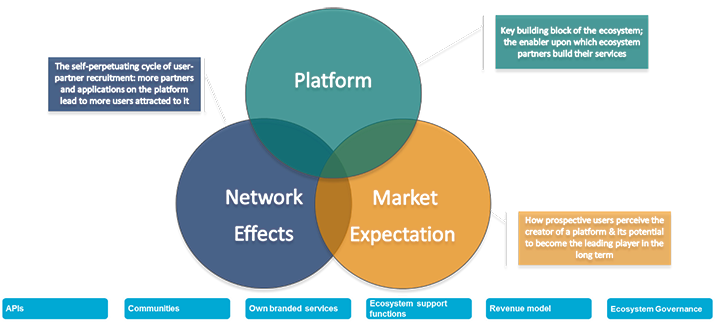Three main elements that make up a successful IoT ecosystem
The Internet of Things (IoT) is one of today’s most widely discussed technology topics. From smart agriculture through to smart cities to smart factories, the expectation is that IoT will be transformative. The 4th industrial revolution. However, the reality is that IoT still remains a promise. And, more significantly, IoT remains fragmented. Indeed, most of the applications that do exist are vertical solutions that do not represent a dynamic, interconnected world that the name, internet-of-things, would suggest. One key cause is the lack of true IoT ecosystems.
The IoT ecosystem
Clearly, no company has the capabilities and resources to do it all in the IoT. Instead, businesses targeting this opportunity will always be part of an ecosystem. This means that ecosystems are ultimately the competitive unit in the IoT – and that the battle will be between these ecosystems, not between individual companies. Moreover, there will not be single but many interlinked ecosystems. An ecosystem of ecosystems if you will.
Notably, an ecosystem is more than a set of arms-length partnerships. It is a network of independent contributors who interact closely to create mutual value. This, in turn, creates interdependency among partners in the ecosystem. All partners share the same fate – individual partners will be successful only if the ecosystem is successful. This complex dynamic presents a challenge for businesses trying to figure out an IoT strategy. A better understanding of how ecosystems are created is required.
Key elements and enablers for developing an IoT ecosystem
As shown in Figure 1, there are three main elements that make up a successful IoT ecosystem: these are an IoT platform, the market expectation and the network effects.

Figure 1: Elements and enablers of an IoT ecosystem
The platform is a key building block of the ecosystem and the focus of much investment and commentary in the industry. Examples include Microsoft’s Azure IoT suite and AWS IoT. Whereas this element is key, it is the other two that are more nuanced and challenging for businesses to figure out. Indeed, building an IoT ecosystem is a complex undertaking with many interconnected factors that need to be juggled with. Supporting an ecosystem requires more than just having a platform and making APIs available to third parties. Companies offering platforms need to be able to create the right incentives (financial and other kinds), support systems for partners, and define how they – and not competing players – will create more value for their partners.
Key enablers when developing their IoT ecosystems
There are a number of key enablers that enterprises should focus on, when developing their IoT ecosystems. These are briefly discussed below.
Enabling platforms
Aas mentioned above, platforms are the foundation of the ecosystem. Businesses need to deploy IoT platforms that fulfil the expectations of both customers and partners in terms of functionality, reliability, security and flexibility. The platform needs to enable not only vertical solutions, but a true ecosystem in the form of a marketplace for IoT products and services.
APIs
APIs are the basic building blocks of an IoT ecosystem, and businesses must therefore develop a strong API strategy. This strategy should be based on a deep understanding of the IoT markets that the business intends to target. Designing and supporting APIs for everyone is impractical, which means that a focused approach is recommended. The business should also develop an API roadmap that is in line with its overall IoT strategy, while the API pricing and support model must be aligned with the business’ ecosystem revenue model. APIs can ultimately foster – or discourage – network effects. If using your APIs is too onerous or does not create sufficient value, ecosystem partners will be reluctant to invest time or effort. It is therefore vital that businesses define their API strategies with market and partner needs in mind.
Communities
For ecosystems to be true ecosystems, communities of partners need to exist. These partners should be able to develop products and services based on the company resources (via APIs), as well as those of other ecosystem participants. The benefits to businesses can be immense. By enabling others to invest and create new products and services, the business is able to boost innovation. This is achieved without incurring every cost and risk involved, but by sharing these with the ecosystem partners. Companies like IBM, Amazon and Microsoft are very active in this area sponsoring hackathons and sponsoring university research programs and incubators. Find more about 10 Rules Behind Amazon’s Success You Can Use on Your Digital Transformation Journey.
Own branded services
In many cases, it makes sense for businesses to offer complete IoT solutions, either with their own products or through integration with partners. This to signal commitment to market and to kick-start the ecosystem expansion. A good example is Digital Life from AT&T, a telco in the US – the company has developed an integrated home monitoring service together with partners, and markets the service as an AT&T-branded product. This branded service serves to signal AT&T’s commitment to the IoT and, as the service establishes itself in the market, AT&T is looking at opening it to a wider array of partners, thus further developing the initial ecosystem.
Revenue models
Revenue models are a key aspect for the successful development of IoT ecosystems. Businesses looking to attract ecosystem partners need to define the right revenue generation and sharing model – one that incentivizes partners to join the ecosystem, reduces risks for partners to innovate and fits with the business model of the individual partners. Some partners will be attracted to a revenue sharing model, while others will prefer a licencing or fixed royalty-based model. Models like “freemium” can be good to encourage experimentation and early adoption in IoT communities. This means that firms will need to support several revenue and partnership models, which in turn will require new decision and management systems.
Ecosystem support functions
The final (and perhaps most overlooked) enabler is the internal organization and the related support functions. A critical function here is partner management, which not only means being able to recruit but to incentivize and support ecosystem partners throughout the partnership lifecycle. This is a capability that goes beyond basic reseller agreements. Businesses will also require dedicated teams to support the ecosystem. This support includes technical (e.g. how to use an API) but also marketing (e.g. sell your apps on our marketplace) and operational (e.g. “fulfilled by Amazon”).
Moreover, a governance model that establishes clear ‘ecosystem rules’ is critical in order to maintain harmony among members and a healthy cooperative ecosystem.
The High Potency of Low Power in the IoT Ecosystem
The network characteristics of IoT ecosystems based on wireless technologies are quite different from those for traditional wired or wireless networks because the number of devices participating in communication is very large. Also, traffic per IoT device is typically not so big because each IoT device senses and transfers a small amount of data to a corresponding IoT server. Although data generated from a huge number of objects may collectively have some impact on the network performance. Furthermore, IoT networks should operate stably and sustainably for a longer period without any need for human intervention.
The driver of Low Power in the IoT Ecosystem
Although the backbone architecture of networks hogs the limelight in a typical IoT program, the actual driver to a successful deployment of the network hinges on the devices at the edge.
This “edge effect” is amplified given the numbers, and the challenge is exacerbated when the connectivity and computing being wireless. Just imagine if these have to be kept charged, imagine the form factor of the devices and the energy bills to the boot. More about Enabling a New Era of Industrial IoT with Free-Use Wireless Spectrum
So these “edge devices” or the “IoT end points” need to be extremely inexpensive, with minimal form factor with low or no demands for power, and the need to be autonomous (untouched by human command). The ideal situation would be to make these edge devices run on any electricity (or provide access to foraged electrical energy from heat, motion, light that could be converted to electrical energy.
So the device should have the capability to may be work for a decade powered by a small battery and/or through the energy foraged from the ambiance it is operating in as mentioned above
The impact of Low Power in the IoT Ecosystem
Here the aggressive R&D on Low Power or No Power devices (LO-NO-PO) makes a grand entry to address this conundrum smartly.
When the operating voltage decreases, the similar power consumed drops and so also the performance. While this may adversely impact one’s music system, but this is what is required precisely for an “edge device.”
Exploiting this has led to the emergence of “subthreshold “processing. This technique allows the IoT microcontroller to run from a voltage supply lower than the transistor’s switching voltage. The solution which is being perfected is Sub Threshold Power Optimised Technology (SPOT) which has been pioneered by companies like Ambiq and Minima aided by university led the academic research.
While these products are getting ready to come to a mainstream, they are addressing some of the challenges of making the devices less sensitive to factors like temperature, noise, and other environmental factors.
Conclusions
In the battle to establish leadership in the IoT, ecosystem will ultimately be the competitive unit. At the same time, building an IoT ecosystem is a complex undertaking that requires many interconnected factors to be balanced. The challenge for businesses is to establish an IoT ecosystem strategy that is holistic, taking into account all the elements described above and adopt a smart manufacturing ecosystem mindset that moves away from vertical value chains with one set of customers at the end of it. Indeed, when it comes to developing an IoT ecosystem, businesses need to take the view that they have customers not only in the form of end-customers, but intermediate customers in the form of partners who need attracting, supporting and delighting just as much as an end customer.
 The article was written by Omar Valdez-de-Leon who is a Principal Consultant in Ericsson’s Consulting & Systems Integration organization. Additionally, he provides independent advisory services and lectures on digital transformation. His experience in IoT ranges from advising utility companies on smart grid strategies to devising IoT plans for large Telecom operators and smaller start-ups. He has also built, launched and managed IoT solution portfolios in utilities, transportation and retail. Originally the article was published here.
The article was written by Omar Valdez-de-Leon who is a Principal Consultant in Ericsson’s Consulting & Systems Integration organization. Additionally, he provides independent advisory services and lectures on digital transformation. His experience in IoT ranges from advising utility companies on smart grid strategies to devising IoT plans for large Telecom operators and smaller start-ups. He has also built, launched and managed IoT solution portfolios in utilities, transportation and retail. Originally the article was published here.



